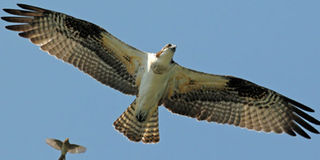Uganda, hub for birds on the move

The Osprey bird. Two weeks ago, a similar bird was found near Entebbe International Airport. It is believed the bird had flown from Finland.
The peninsula of Entebbe, located on the Asian-East African flyway, a migratory path of birds moving from the northern to the southern hemisphere, is a favourite resting place for the birds.
As such, it came as no surprise when two weeks ago, an osprey was found near Entebbe International Airport after flying from Finland.
Vincent Mugaba, the spokesperson Uganda Tourism Board, says Entebbe is an important area for migratory birds.
“For birds of prey, the lake is a source of fish and other foods, and the swamps around it provide a good haven for the birds to breed.”
Why do birds migrate?
Almost all birds in the northern hemisphere migrate, the distinction is in the distance they go from their natural habitat. For instance, long distance migrants will breed in Europe and winter in Africa. These species include swallows.
There are many reasons why birds will make these seasonal movements. The availability of food will influence a species’ decision to migrate. When food is scarce, the bird will migrate to look for it.
The availability of food is also tied to the changing weather patterns because if the summer is longer in the northern hemisphere then breeding birds will not go in search for food for their younger ones.
“For some, it is to get to warmer climates and escape the winter,” Mugaba says, continuing, “Others migrate to breed in ideal environments for their young to grow. The seasons determine the distribution of birds, with some arriving in October and flying back in March. Some birds arrive in April and leave in October while others arrive in August and remain until April.”
If the winter is particularly harsh, and there is nothing growing on the trees or on the ground, the birds travel to warmer regions which have a constant supply of food.
“Some birds migrate only to Africa. These intra-African migrants arrive in July and start leaving in December. The warm and relatively stable climate through the year makes Uganda an ideal home for birds.”
How they fly
The cue for migration would be the heralding of autumn. Birds can detect this through the changing length of the day.
Scientists believe these changes in the environment are related to hormonal changes in the birds because towards that time, they display a high level of activity.
Before they fly, the birds accumulate enough fat and learn to control their sleep patterns. Also, some species molt their feathers.
A flock of migrating birds flies in a vertical line, forming a broad front.
They follow a flyway or migratory path that follows coastlines, rivers, and mountains using the direction of the sun as a compass.
The path taken when migrating is not the same path they use when returning to their breeding grounds.
Danger of migration
Birds carry ticks and lice and migrate with them, causing concern to human health.
“To travel and survive those long distances without resting, the birds must be healthy,” Mugaba says adding, “I have not heard of any report of birds bringing disease from or to Europe. Uganda provides a great climate and environment, which is why Uganda is considered a top birding place.”
Human activities on the flyway, for instance, use of pesticides and hunting, also threaten the migrants. Mugaba says protection of the environment is key to ensuring bird protection.
“We are encouraging people to plant trees. Degradation of wetlands, mountain foliage and water sources should stop. Besides poaching, the greatest danger to birds is degradation of the environment. Human activity in some areas should be limited or changed to allow for co-existence.”
Uganda, the bird habitat
Uganda is recorded to have an avian diversity of 1,008 species, although only one, the Fox’s weaver, is endemic (native) to the country. Birdwatchers would want to try out Budongo, Kibaale and Bwindi forests for an extensive tour.
Otherwise, Botanical Gardens, Lutembe Ramsar Site, Uganda Wildlife Education Centre, Mabira Forest Reserve, and Mabamba Bay are a good starting points.




